The main types of haworthia

Haworthia is a graceful plant that occupies a special place in the list of domestic perennials. In terms of external characteristics, it is distinguished by its small dimensions and graceful shape. Quite often, Hawortia is confused with a cactus. Indeed, the green color of the plant and the presence of teeth located along the contour of the leaves in some varieties of succulent can be misleading. Therefore, novice growers should familiarize themselves with the distinctive features of species adapted for indoor cultivation.
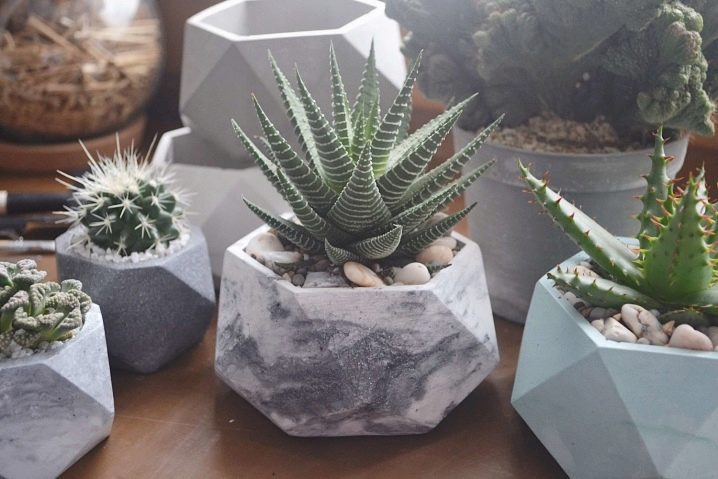
Description
Haworthia is a stunted succulent of the Ksantorreev family. In the wild, it is found in desert places. The homeland of the flower is the southwest and south of Africa. Plant height reaches 1 meter, and domestic specimens grow to a maximum of 15 cm.The life cycle of Haworthia is 20 years. Each year, the flower is supplemented with increments, and after death it is replaced by children.
A rosette is formed from the dense leaves of haworthia, located on the surface of the soil. The plant has no stem. The flowering period begins at the end of May, sometimes at the beginning of June. In the wild, Haworthia blooms annually, and in a room environment only with proper care.
Experienced flower growers advise not to admire the flowering, but immediately cut off the buds that have appeared. Otherwise, Haworthia will spend its energy on growing flowers, and having wasted energy, it will die.
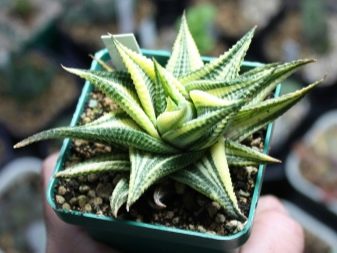
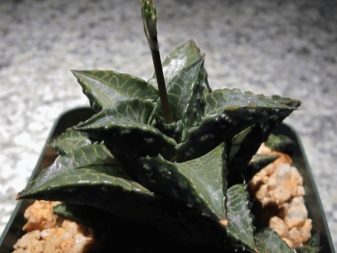
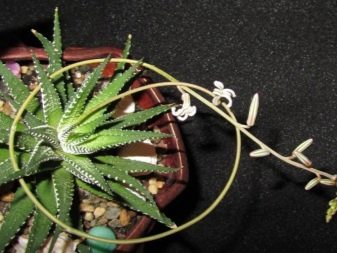
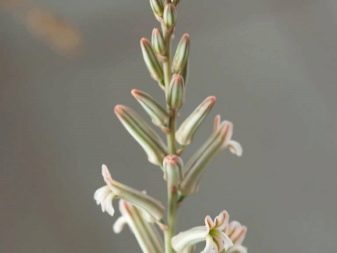
Types and varieties
After a long study of Haworthia in the wild, botanists have identified about 70 species of it. Almost half of them managed to get acclimatized at home, for example, the varieties "Alba" or "Big Band". In the homes of sophisticated florists, there are such plant names as pumila and truncated haworthia. Below are the most popular succulent species that have managed to adapt to the indoor habitat.
Pearl
The second name is pearl-bearing haworthia. The plant has dense leaves, on the surface of which white blotches are located, resembling the image of pearls. The tips are pointed, small spines are visible along the edges. Inflorescences resemble brushes with a green color. At the end of the flowering period, the rosette rots, leaving behind daughter shoots.
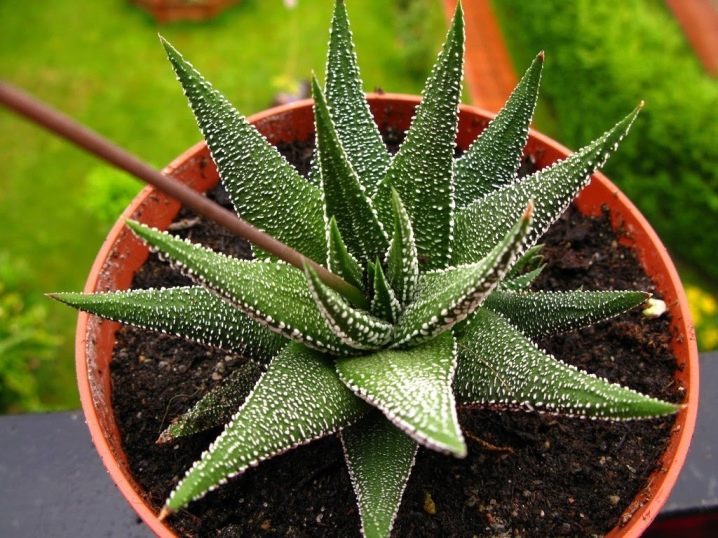
Striped
In the botanical world, they prefer to call Haworthia Fasciata (Haworthia fasciata), which means striped. The rosette of the represented plant is 15 cm in diameter. The base of the rosette consists of luxurious elongated leaves, the lower part of which is covered with a relief pattern, white blotches are visible on the surface. Looking closely, you can see how the striped pattern becomes clear on the sheet plate.
The attractiveness of decorative haworthia is due to the numerous daughter outlets that can be transplanted.
The Concolor variety, which belongs to the type of striped Haworthia, is in great demand among breeders. Its special feature lies in the barely noticeable pattern on the leaves.
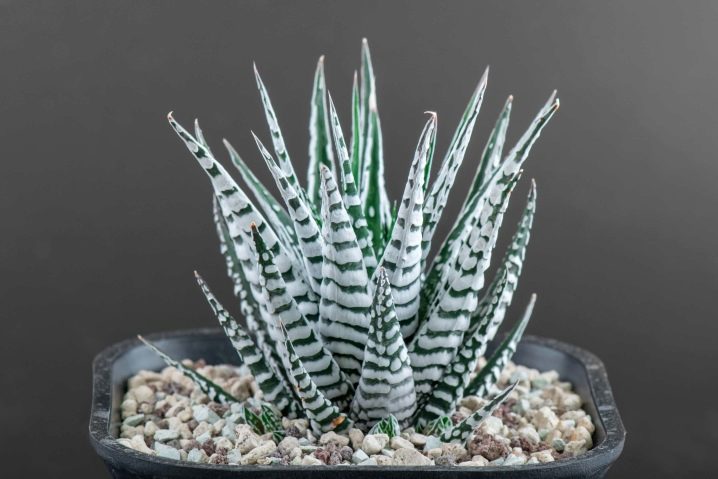
Reinwardt
Succulent in shape resembles the Leaning Tower of Pisa. The maximum plant height is 15 cm. The dense, fleshy leaves are covered with a whitish outgrowth that disappears from the excess of the shady side. The peduncle grows up to 1 meter. On its surface, bright green flowers appear, folded into the shape of a brush.The main part of the plant is colored violet-red, in some cases green with whitish blotches.
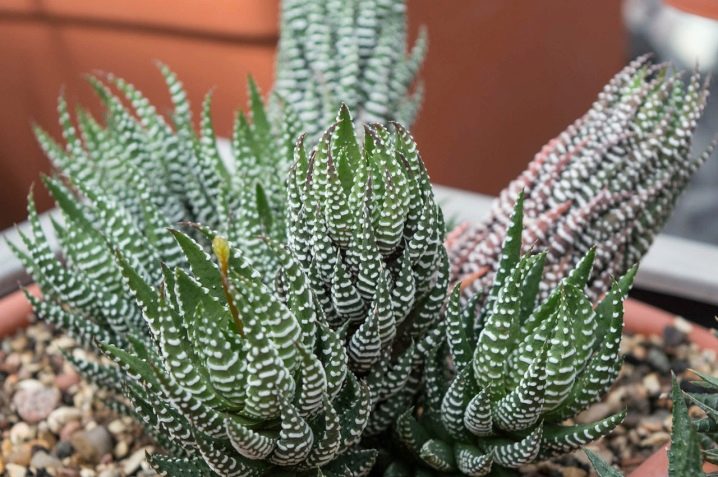
Drawn or attenuated
In appearance, it is similar to the striped haworthia. Although it does not look so elegant and rich. There are no outgrowths on the leaves, instead of them, whitish warts are visible, resembling uneven dots in shape. Flower leaves grow vertically. Their maximum length is 7 cm, the thickness of the sheet plate is 15 mm.
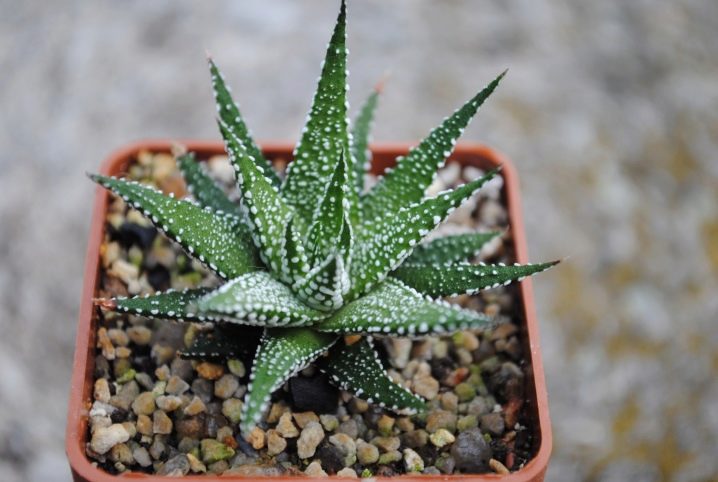
Scaphoid
The flower shape is quite graceful and compact, reminiscent of a violet. The leaves are dense, characterized by a bright green color with lightened tips. The leaf plates gather at the base and create rosettes. During the flowering period, the scaphoid Haworthia blooms small flowers, mostly white.
The variety "Cymbiformis variegata", which belongs to the type of scaphoid plant, is in wide demand for flower growers.
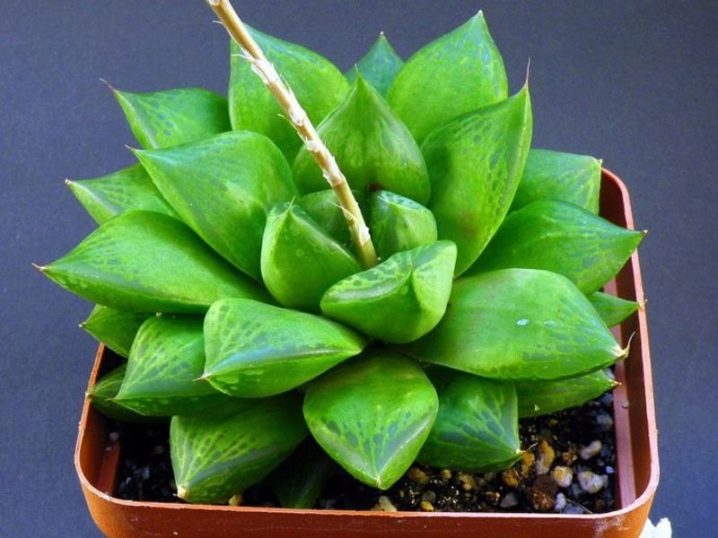
Cooper
Succulent plant with a special form of structure. At the tips of its leaves, growths appear in the form of small translucent windows. In appearance, the plant resembles a dull haworthia. On the other hand, there is a similarity with the scaphoid representative of the Ksantorreev family. The maximum height of a domestic succulent is 20 cm. The leaves grow 3 pieces in a row, giving the plant a special shape.
The surface of the sheet plate is rough to the touch, and thus attracts attention.
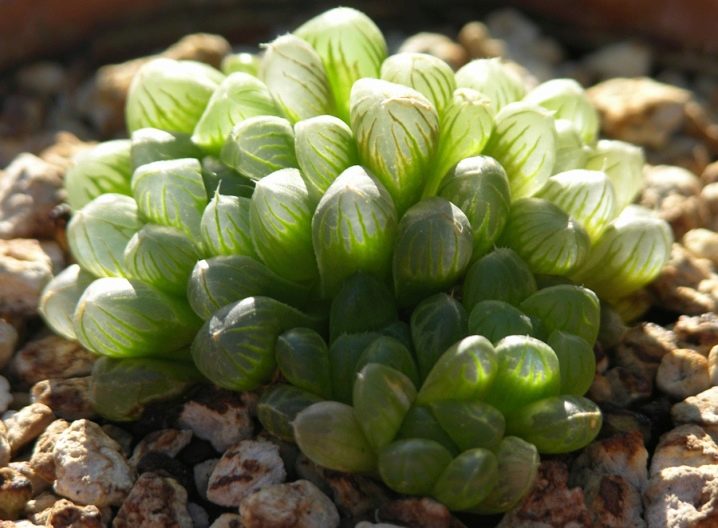
Sinuous
In a botanical environment, succulent has a second name - winding aloe. The presented species has a trunk part, the height of which is 15 cm. On all sides it is covered with small leaves of green shades with a maximum length of 3 cm. A distinctive feature of the leaf plates is a rough surface, complemented by whitish growths. The leaves grow on top of each other, thus creating one rosette above the other.

Sticky
In the botanical environment, the presented variety of Haworthia has a second name - viscose. The maximum plant height is 20 cm. The leaves grow 3 pieces in a row at the same height. The following sheet plates are neatly stacked on top. On the one hand, they have a convex part, on the other, they are concave inward. Therefore, they resemble the shape of a stack of napkins. If you look at the plants from afar, because of the color, it may seem that there is a snake in front.
A distinctive characteristic of haworthia gummy is the possibility of its growth both on the sunny side and in the shady part.
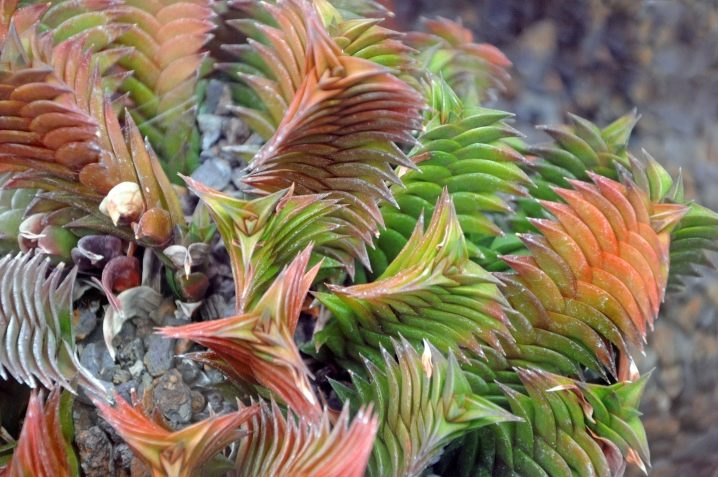
Mosaic or checkerboard
The presented haworthia has dense, fleshy leaves with a scalloped edging. The leaf plate is decorated with a natural pattern of stripes that create a mesh image. In the wild, the mosaic Haworthia blooms twice a year. In a room environment, this process occurs every 2 years. If you want to buy the described succulent, you should go to a flower boutique, where a plant in green and purple will be presented at the buyer's choice.
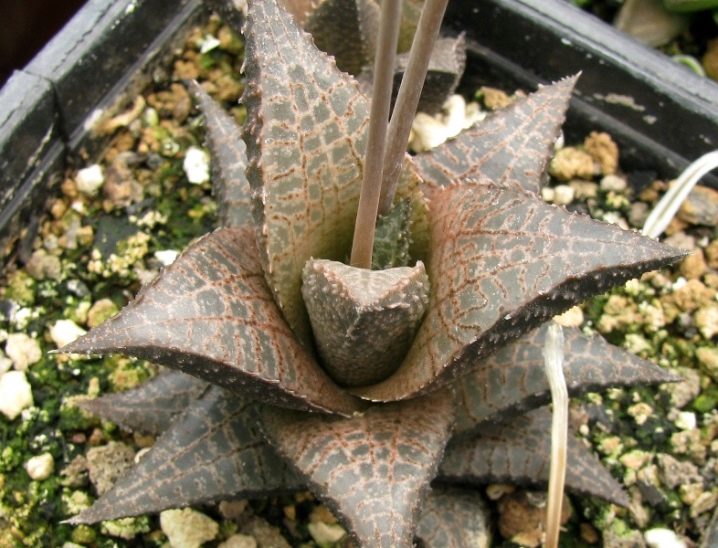
Terkovidnaya
Outwardly, it resembles a pearl-bearing haworthia. The leaves are narrow and rather elongated in thickness. Their tips are pointed. On the back side of the sheet plate, there are a huge number of growths. There are much fewer of them outside. The resemblance of warts is scattered on the leaves in a chaotic manner, without making a certain symmetrical pattern or clear lines.

Limoliferous
The peculiarity of this type of haworthia is dense and pointed sheet plates. They have ribbed edging stripes and raised portions of the ribs. A distinctive feature is a complex ribbed pattern with bilateral symmetry. The outer part of the leaves is yellowish, reminiscent of the color of lemon. In home gardens, it is quite rare, but still there are varieties of Haworthia Limifolia and Spider White, belonging to the limolous species.
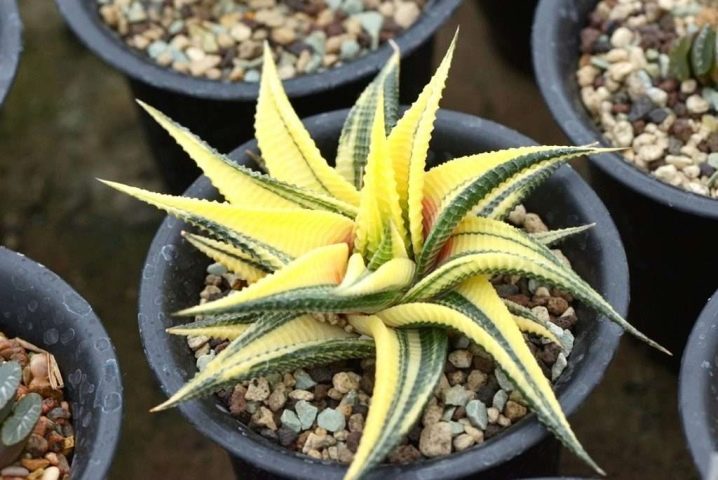
Herbaceous
Thin and narrow leaves of the plant are decorated with small edging thorns. The light and supple character of the flower allows you to play with it in an unpretentious game with light. When rearranging the container with herbaceous haworthia from one place to another, you can see how the color of the leaf plate changes from bright green to light green and vice versa. And all because of the change in natural light.
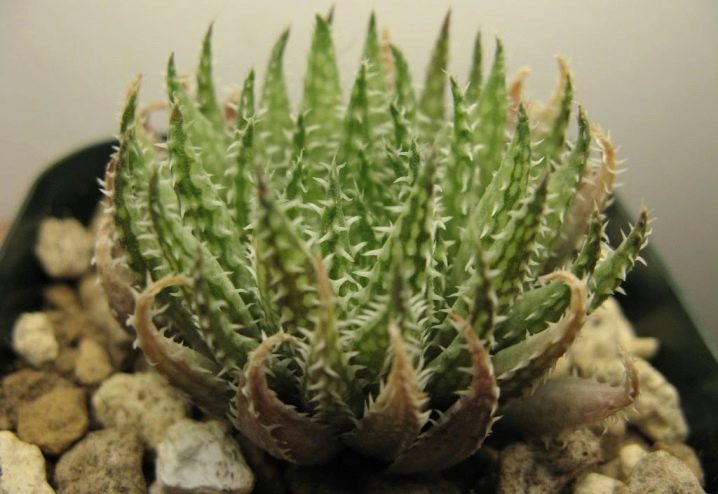
Cobweb
In appearance, it resembles grassy haworthia, at the same time it has its own characteristics. The thorns on the leaves of the succulent represented are very long, in the process of growth they are able to braid a growing bush with a cocoon-like cocoon.
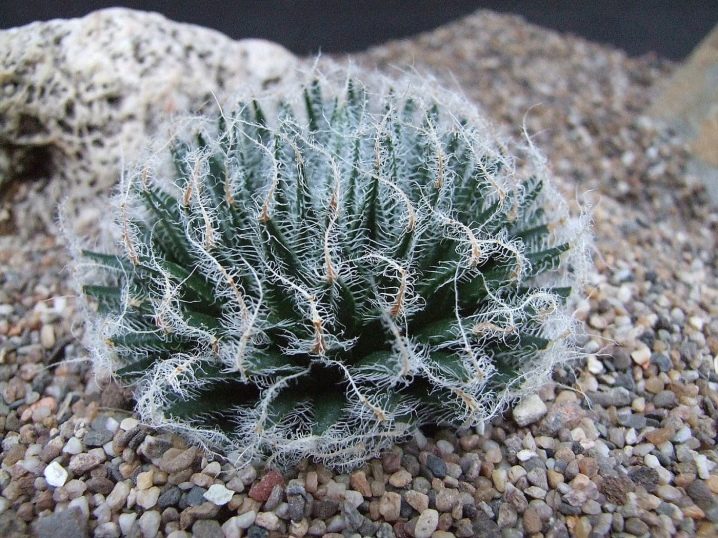
Retuza or blunt
The peculiarity of the presented succulent is the closely assembled leaf plates. Loves diffused sunlight. When in the shade, its leaves turn red. In appearance, Haworthia Retusa is similar to the Pygmy variety. Only in size is it more miniature, and the tips of the leaves have many small growths.

Dwarf or pygmy
In the botanical environment, dwarf Haworthia has a second name - Pygmy Haworthia. The leaves of the plant are very small, tightly pressed against each other, due to which they create an incredibly beautiful rosette. The surface of the plate is rough to the touch.
By nature, the succulent is unpretentious. For its reproduction, you can use leaves, daughter processes or seeds.
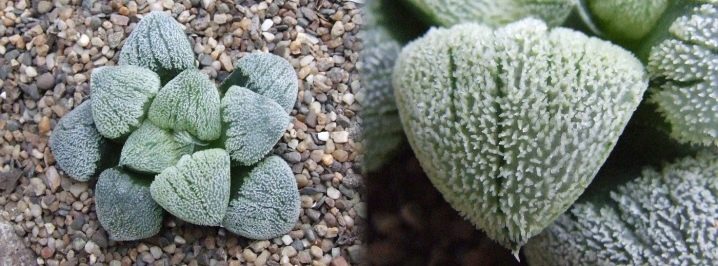
Marginata
The peculiarity of the plant lies in the leaf plate, which in appearance resembles an artificial glossy plastic with a dense texture. In terms of color, the leaf plates are slightly different, the outer leaves are darker, and the inner young leaves are slightly lighter. The flower stalks that appear at the end of the haworthia marginata release a huge number of small flowers, thanks to which you can collect enough seeds for planting.
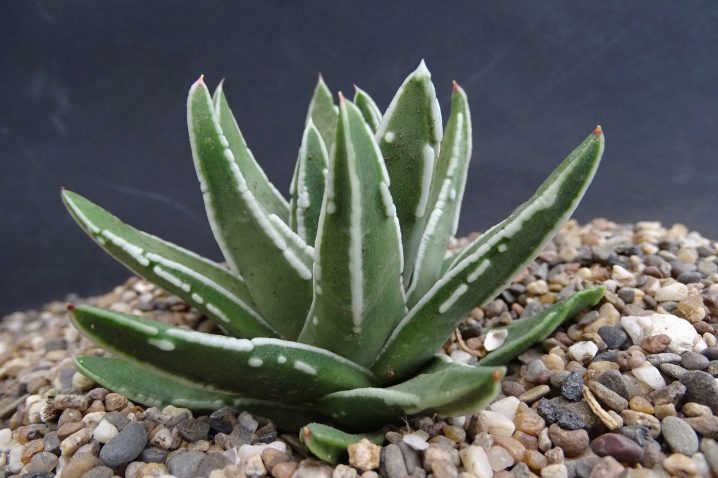
Atrofuska
Large fleshy leaves are located close to each other. In terms of color, the leaf plates are reddish. When exposed to sunlight, they can shine through, thereby resembling precious stones. The atrofusk is not high in size, and rather diminutive in size. During the flowering period, a small peduncle opens on the surface of the plant, in which you can see inconspicuous flowers.
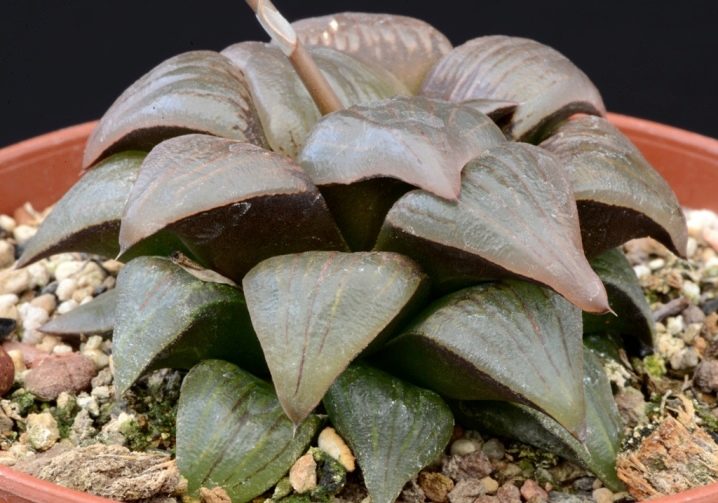
Chopped off or trunkata
Quite an interesting plant of an unusual shape. It may seem that its leaf plates were cut in a chaotic manner. In fact, Mother Nature tried so hard. The leaves of haworthia trunkata do not have pointed ends. They seem to have been cut with a pruner or knife. The cut surface is white, slightly transparent.
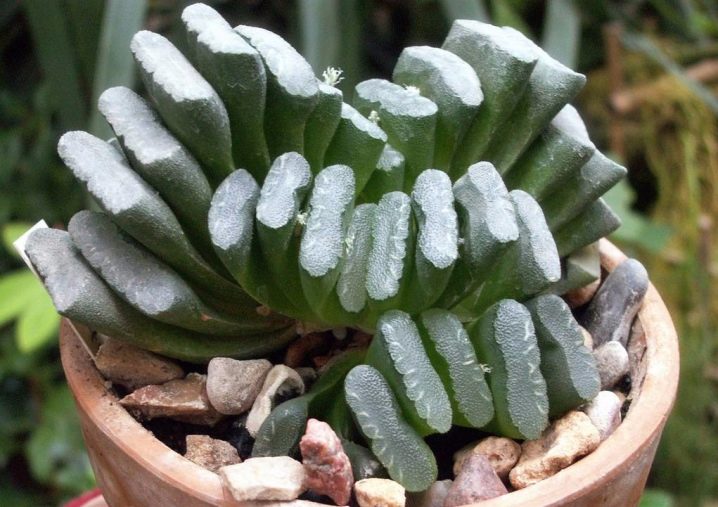
Maugani
In appearance, the plant resembles a chopped off haworthia, with the only difference that on the surface of the chopped off sheets there is a transparent cylindrical film resembling transparent glass. The peculiarity lies in the variety of colors. Leaves can be gray-green, white and even brown. From a distance, the plant resembles a cluster of crystals. In flower shops, the name "Haworthia mix" is quite common.
A flower grower must know that this is not a type of plant, but the planting of several types of succulent, similar in size, in one container.
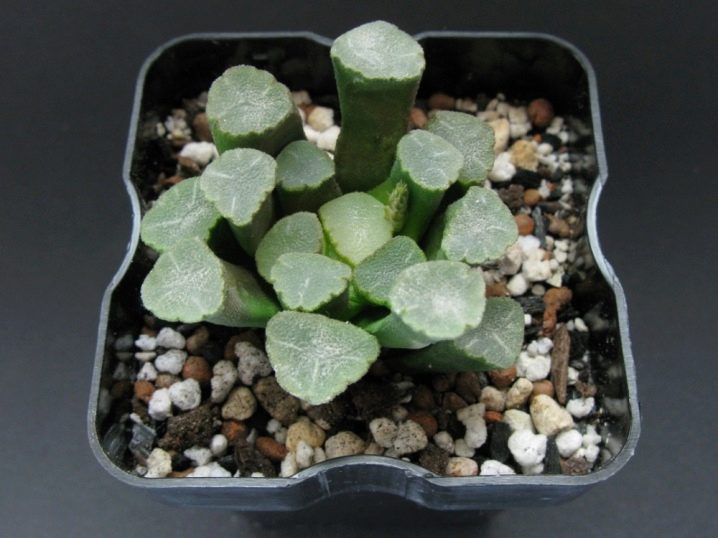
How to choose?
Modern flower growers go to flower shops to purchase indoor plants. It is there that you can choose the most suitable flower specimen for your mini-home garden. As for the choice of Haworthia, there are several rules to follow. To begin with, it is worth deciding which type of succulent is most preferable, as well as choosing the optimal dimensions of the flower for placement on the windowsill.
The leaf plate of the selected flower must be healthy and free from spots of a distinctive color. When buying, you need to slightly lift the lower outlet and look at the covered ground.Quite often, inexperienced growers acquire plants without preliminary examination and bring harmful parasites home. In general, choosing a healthy succulent plant is quite simple.
The main thing to remember is that when the plant is delivered home, it should be transplanted into a new container with suitable soil.
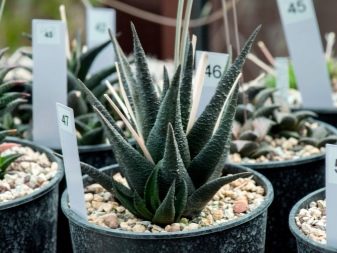
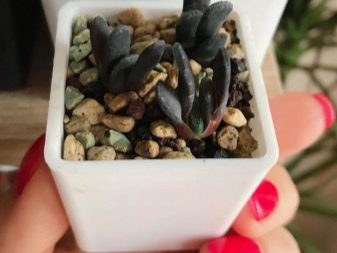
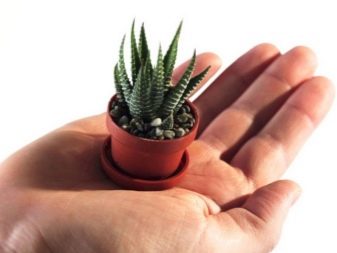
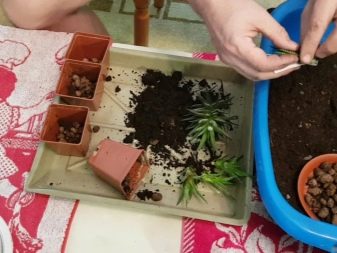
Basic rules for growing
Regardless of the type of haworthia, plant care should be worthy. Timely watering, proper feeding and sunbathing are important. In the wild, the plant lives on its own, at home it is completely dependent on the owner. If all the rules are followed, the florist will see a reaction from the succulent in the form of good growth and flowering performance.
- When placing a flower on a windowsill, remember that Haworthia loves diffused light. The best option would be the west or east side of the apartment. Otherwise, the plant will have a deficiency of sunlight, it may die.
- Winter is the hibernation time for Haworthia. For a cool period, the plant must be rearranged in an unheated room, where sunlight enters.
- The main characteristic of Haworthia is frost resistance. In the wild, it is ready to withstand a drop in temperature to -7. Although the optimal range for plant life is around + 5 degrees. In the summer, it is better to keep the flower outdoors in a place protected from weather factors.
- Haworthia does not like abundant watering; this plant prefers a moderate, humid environment. During the growing season, the plant should be watered more than 2 times a week. Winter watering depends on the indoor temperature. After each watering of the Haworthia, you must wait a while to drain the water that has drained into the sump.
- Water fertilization should be used as fertilizer. It is necessary to enrich succulent with vitamins from the onset of spring to the end of summer. With an excess of nutrients, Haworthia will give a sign by changing the color of the leaf plate.
- Under the influence of negative factors, the plant can infect various diseases or parasites. For example, scale insects and mealybugs. A hot shower and insecticide treatment will help get rid of the painful condition.
- The procedure for transplanting young plants should occur once every 3 years, as the size of the succulent increases. Adult Haworthia is transplanted every 2 years. If the growth process of an adult plant moves gradually, and it is placed in containers, the procedure should be postponed. In case of death of the roots, the transplant is done immediately.

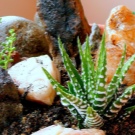
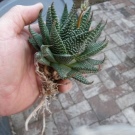
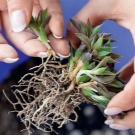

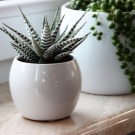
Following the presented rules, even a novice florist will be able to grow an unusual and beautiful decorative haworthia in his mini-garden, wait for its flowering, and then propagate it.
About the succulent plant - Haworthia: types, care and breeding at home, see the next video.


















































The comment was sent successfully.